The Ministry of Defence has taken a significant step in advancing the Future Air Dominance System (FADS) and Britain’s next-generation Type 83 Destroyer programme by seeking market engagement.
This effort, designed to transform the UK’s air and maritime defence capabilities, highlights the government’s commitment to securing innovative solutions for future challenges.
According to the information I read this morning, the FADS programme is envisioned as “a transformative multi-domain programme that will provide Integrated Air and Missile Defence against the toughest of threats in the air domain, and strike against the hardest of targets in air, land, and maritime domains.”
The Type 83 Destroyer, a critical component of this system, is expected to succeed the Type 45 Destroyer in delivering air defence for the Carrier Strike Group and Littoral Strike Group by the mid-2030s.
The MoD emphasises a “system of systems” approach for FADS, focused on the themes of “sense, decide, effect, enable, and host.” This comprehensive integration of technologies underscores the government’s ambitions to maintain a cutting-edge defence capability.
The MoD’s Defence Equipment & Support (DE&S) team is inviting industry experts to participate in a Market Engagement Event (MEE) scheduled for December 2, 2024. The event aims to provide insights into the programme’s direction and gather input from industry stakeholders.
The PIN highlights the objectives of this engagement: “to gain a greater understanding of the marketplace capabilities, capacity, and skills regarding the potential requirement(s); understand where industry sees challenges and opportunities in relation to the potential requirement(s).” Interested parties are required to register by November 27, 2024.
The MoD notes that the MEE will include “a presentation by the Authority to industry to provide an overview of the programme, high-level requirements, and timescales.” For those unable to attend, a repeat session may be held in early January 2025.
The MoD further clarifies, “For the avoidance of doubt, this notice is not informing the market of an imminent procurement.”
The Type 83 Destroyer was first announced in the 2021 Defence Command Paper, “Defence in a Competitive Age,” as part of the UK’s broader shipbuilding strategy for 2030. While detailed designs remain undisclosed, concept images unveiled at recent naval conferences hint at advanced capabilities tailored for modern warfare, including robust fire safety, damage control, and operational versatility.
The FADS programme, which includes the Type 83, will align with the government’s shipbuilding strategy to deliver cutting-edge platforms that can address evolving threats. The MoD states, “The First of Class platform is planned to be in service in the later 2030s.”
A concept image emerged in 2023, potentially showing Britain’s new Type 83 Destroyer, the image emerged during a presentation at a naval conference.
The presentation, aimed at shedding light on the current and future advancements in warship design with respect to fire safety and damage control, contained a slide showing a potential concept image for the Type 83 Destroyer.
The following is my attempt at enhancing the image.
The Type 83 Destroyer project was officially unveiled in March 2021 through the publication of the United Kingdom government’s defence command paper titled, ‘Defence in a Competitive Age’. Within this paper, the Type 83 Destroyer was referenced in association with the government’s shipbuilding strategy for 2030, outlining planned sustained investments in naval development.
In February 2022, the Ministry of Defence verified that the Type 83 Destroyer is being engineered to counter the emerging threat posed by hypersonic missiles. Additionally, as pointed out above, it is contemplated that the vessel will be integrated into a broader defence framework known as the ‘Future Air Dominance System’.
The Type 83 Destroyers are expected to come into service in the latter part of the 2030s, replacing the existing Type 45 Destroyers.
Back to the image, though not high resolution, it provides a tantalising glimpse into what the Type 83 Destroyer might entail. The ship’s sleek design is immediately apparent, with a distinctive hull that prioritises stealth and speed and is somewhat reminiscent of Type 26 Frigate and Type 45 Destroyer. Its streamlined superstructure is suggestive of advanced radar and sensory technology integration. Of note is CEAFAR.
The concept reveals a ship comparable in size to the Chinese Type 055 Destroyer (which is around 12,000 tonnes) and armed with a five-inch main gun, Phalanx Close-In Weapon Systems, two 30 or 40mm guns and additional unidentified close-in weapons systems, plus a significant missile payload. The missile payload seems to be divided into two sets of Mk 41 vertical launch system cells, each holding an estimated 64 VLS, resulting in potentially 128 missile cells per ship.
Is the image official?
No, not at all. BAE and the Ministry of Defence haven’t commented on this and while the reveal of a potential Type 83 Destroyer concept image may have been unintentional, it has undoubtedly captured the imagination of naval enthusiasts.
Remember, the Type 83 destroyer programme is still in the pre-concept phase.
At the UK Defence Journal, we aim to deliver accurate and timely news on defence matters. We rely on the support of readers like you to maintain our independence and high-quality journalism. Please consider making a one-off donation to help us continue our work. Click here to donate. Thank you for your support!


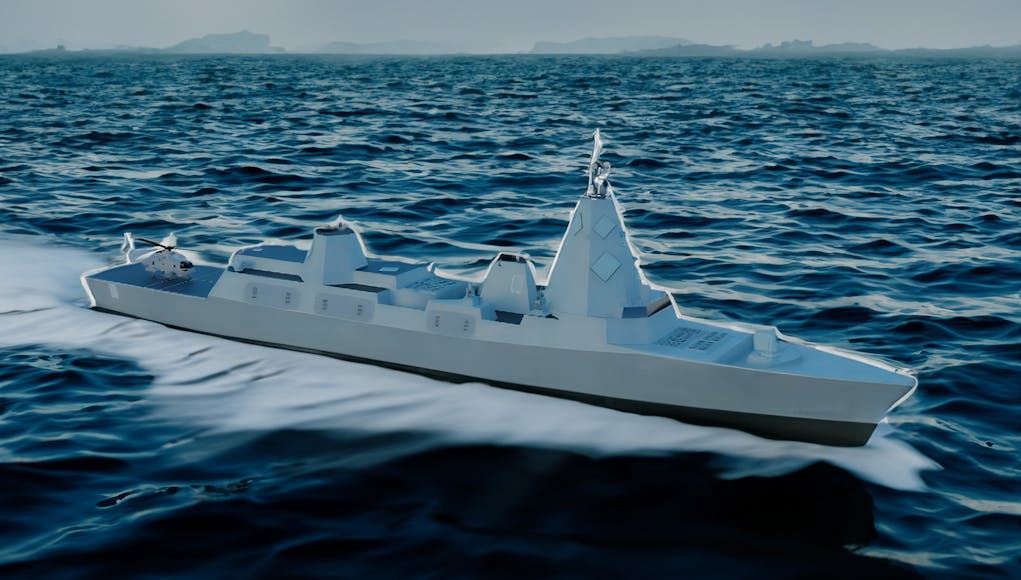
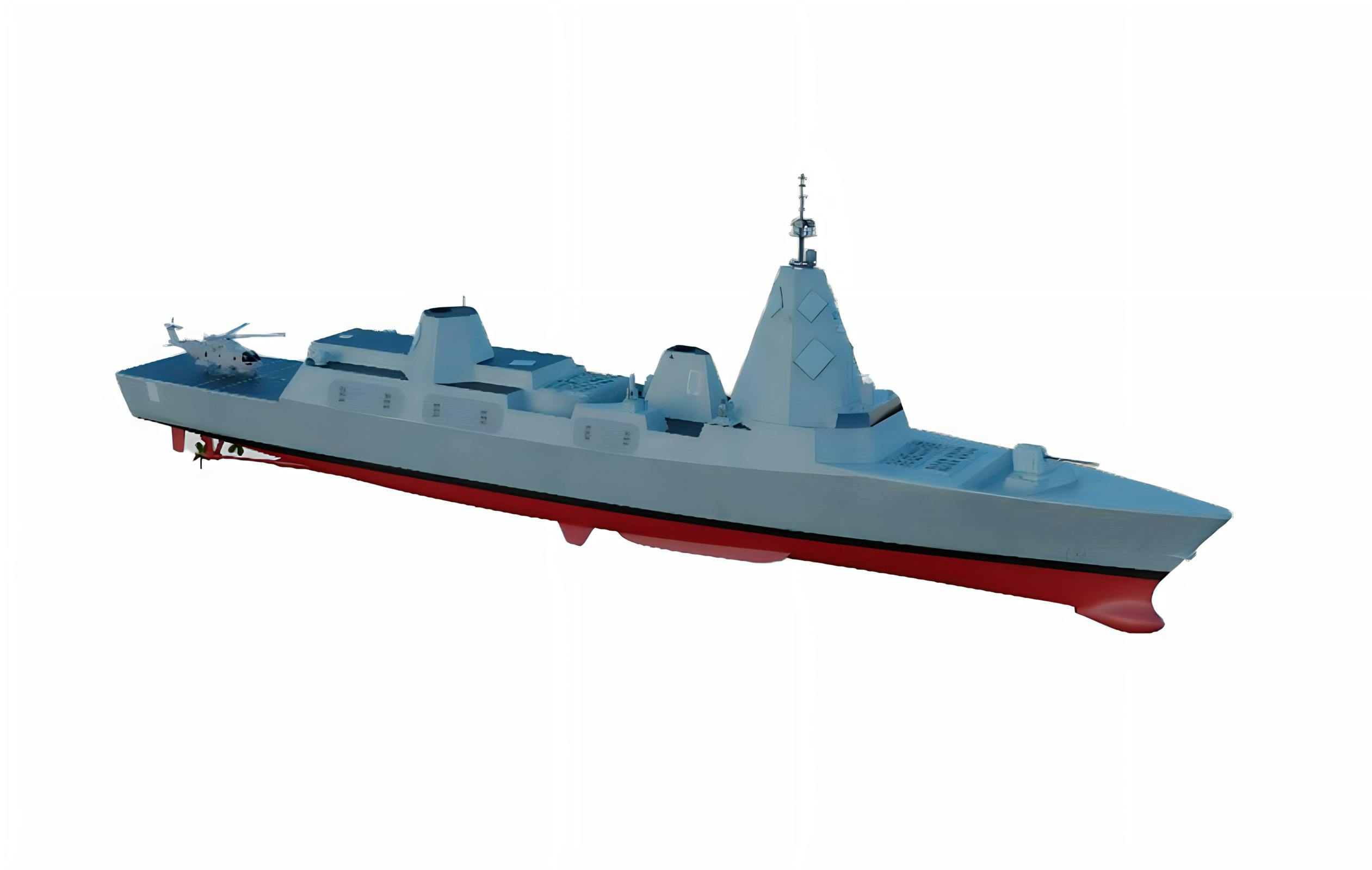


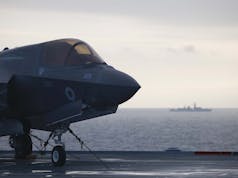
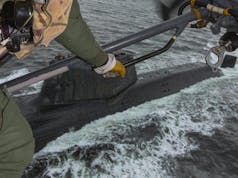

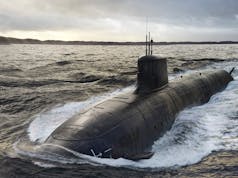


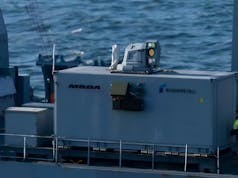


It’s interesting that the 40mm and Phalanx are both there, clearly the former isn’t viewed as a replacement for the latter
The image isn’t official, so I wouldn’t worry about trying to get any details from it.
I’ve seen it in concepts for MRSS as well though, and 40mm is lacking in the independent targeting department
Probably be fitted for not with.
I’m split between using a modified Hunter class platform, over an all new design for T83.
Certainly the all singing all dancing cruiser sized brute described above is tempting.
My fear is that it would be ‘massively’ expensive, not procurable in sufficient number and practically zero chance of exports to offset her enormous cost.
A modified Hunter class would leverage an
good deal of an existing design, provide the required AAW and secondly AsW at a more reasonable cost point.
We are, I fear in danger of going down the Watchkeeper/Wildcat/Ajax rabbit hole again….
Let’s see if hunter actually floats first
The Hunter Class programme has been an expensive mess. Retrofitting hulls is a problem.
Steel is cheap. You’re much more efficient deciding what you want on a ship, then designing a hull to fit it. This is the era of Computer Aided Design.
The costs are in the systems onboard. The radar, VLS, sonar, air defence missile systems etc is where the bulk of the cost lies.
Any issue that comes would most likely arise from the contractor than fleecing the taxpayer rather than the issue being the hull itself.
The latest batch of 10 AB ordered by USN suggests a hull construction cost of @$1b each with @$750 m for the sensors and weapons. So steel isn’t cheap. The final cost of the QEs, equipped with very limited sensors and weapons was 3x greater than the better equipped Italian ships Cavour and Trieste. Building a 10/12000 ton destroyer won’t be cheap either, and would almost certainly guarantee we wouldn’t get more than 6.
Cost can be influenced by efficiency too, Qnlz clsss were delayed to keep shipyards open and spread costs
Steel is indeed cheap. The average Panamax bulk carrier cost is about $70 million at 60,000 tons.
The Italian ships are half the weight and much smaller than QE carriers. Talk about comparing apples and oranges
It would be a shame to skimp on numbers on such a beast of a ship.
The RN will certainly go down a rabbit hole with a modified Hunter Class!
Remember that if you don’t design new ships that skill set atrophies. There’s a reason the US is struggling to introduce anything that isn’t an AB variant.
How is an Early Market Engagement a significant step forward? It’s welcome, of course, a sign that the project isn’t moribund, but a 60 or 90 min Teams presentation by MOD on current FADS thinking, possibly to be repeated in January, isn’t a move forward to the next step, which would be an official shift to the Concept phase.
I understand the cynicism. Do worry that this is as we are seeing with this Govt signs don’t necessarily show commitment. We heard how Starmer was trying to persuade Biden to allow Ukraine to use Long range missiles. Now later he does and Starmer appears to be avoiding answering questions on our own commitment to do so. I accept that there are discussions to be had but it does hint again of talking big when the option isn’t in your gift then thinking again when it is. Just makes it difficult to believe anything when the lips are moving at least until we see actual substance. Not a good look.
As for Aster, I can see a potential move away from it here unless it becomes compatible with Mk-41 which I presume seems unlikely, just think they will want a single VLS fit out or any additional one along with sensor fit will be committed to SeaCeptor in whatever form it is at that point.
I presume by the statement that the image isn’t ‘Official’ it actually means while the MoD released it in an official document, it was merely for general concept illustrative pr general guidance not any official guide to an actual design proposal.
Is the RN going to abandon the PAMS/Aster (Block 1NT and Block 2)? I can’t believe that
We’re moving onto mk41 vls so absolutely we could abandon it. We’re not buying any new asters after all
We’re relifing our Aster 15 to Aster 30 Block 1 standard…and we’re monitoring the Aster 30 Block 1 NT effort.
I would not be surprised to see increased investment into Block 1 NT and further developments like Twister. But we must have increased industrial participation if we are going to continue to be the main user of it.
T83 still a decade+ away so like tomahawk relifing existing missiles may be a stop gap measure
Either way a very big decision isn’t it, so certainly breathing space to commit to what would be a very long term position whatever choice was made is certainly welcome.
That sort of seems to be a sitting on the fence strategy doesn’t it. Going our own way on Block 1 standard to get a capability early gives us plenty of leeway for planning and making a future decision which otherwise we wouldn’t have and leave us by decade’s end very much ‘undergunned’ and desperate. This way it means we can, when necessary still have an able intermediary system while we make a final decision whether to further upgrade it on T-45 and/or what system be it that upgrade or other we use on what replaces T-45 and a stronger bargaining position too potentially as a result with perhaps other options becoming available too if MBDA don’t want to lose the business.
UK is buying Asters.
From this site:
“The defence system will use the Aster 30 Block 1 missile, previously only available in land-based systems, and will be adapted for maritime use.
A £300 million contract for the initial stages of this upgrade was signed last year with MBDA, the European defence company tasked with converting the Aster 30 missile for use on the UK’s destroyers. This contract supports over 100 jobs in the UK across several key locations, including Stevenage, Cowes, Bristol, and Bolton.”
Upgrading, not buying. Our existing stock is being converted to block one Aster 30, including converting Aster 15s
We’re moving onto mk41 vls so absolutely we could abandon it. We’re not buying any new asters after all
Or we could just commit to putting Asters in Mk41s, something we might even get the French and Italians to chip in towards seeing as it’s in their interests too.
You assume LM would allow that, just look at Apache
It’s a reasonable assumption. LM signed an MOU with MBDA in 2013 to integrate European missiles and declared Aster as one of their potential future integrations (still there on their website). Why would they suddenly reverse a decade of policy?
Also LM does not appear to produce much in the way of SAM’s. ie the anti air missiles in mk41’s are not theirs. They need 3rd party missiles to work from mk41 to do that role. LM gains nothing from refusing. If I remember correctly, it’s been verified that Aster will fit, but LM won’t do anything further unless it’s paid to do so & neither will MBDA. CAAM was a little different as it was a whole new family of missiles with high volume potential & only dedicated launchers available.
Never thought of that what’s the process for getting a missile system incorporated into Mk-41 I wonder. And indeed what are France and Italy’s thoughts on future ship designs and VLS. Would France really move away from their own set up. They like to tie in buyers of their platforms to their weapon systems wherever possible. I’m no expert on this but longer term I think we, what with AUKUS et al will if there isn’t a national or European system that can be Mk-41 based for long range/anti ballistic missile defence will go US Standard or its future developments to gain consistency on missiles, sensors and launchers. Will certainly help on missile fit and flexibility and probably ultimate capability too, so a convincing argument technically unless MBDA can argue convincingly and ultimately offer something compelling otherwise.
France and Italy are now working on a universal slyver cell, A70 NG, they may well choose to make aster exclusive if they want to have any market
So a future Potus like Biden will stop the UK launching any SM missiles for months on end, until he nearly leaves office?
If as the article suggests, it’s comparable in size to the Chinese destroyers, will the not-quite-completed Janet Harvey Hall be extended in a few years time or will the ships be built with one end sticking out? I just don’t believe it will be that big, and I don’t think BAES believes it either.
Long debate this. My own feeling is that as only the bow would potentially be beyond the new build hall at most, they would develop a flexible solution to accommodate that. The Chinese Destroyers are 180 m, the build halls are 170m I suspect these destroyers will at most be somewhere in between those figures. Don’t think it is therefore an insurmountable problem.
My point is that if BAES expected the Type 83 to be that big, they’d have built the hall bigger, and who will be offering the design for the ships? If the Navy insists on a particular length of ship just to one-up the Chinese, they need to be slapped down.
Extend the rear of the Build Hall? Those buildings at the back, could be relocated?
If the MOD and RN do go with a design somewhere near the 12,000 tonnes size that George estimates, then there is the option of building them at Harland & Wolff, assuming that the government DOES indeed step in to keep the yard open.
H&W’s involvement with the FSS project implies that HMG will need to address the questions hanging over the future of the yard. IIRC, H&W is also the only UK shipyard with the capacity to build vessels of the projected size of MRSS, assuming the project is greenlit. Rosyth is the QEC drydock facility, so is likely to be ruled out.
My meandering train of thought brings me back to H&W having the facilities to build ships the size that a T83 might be. If 12,000 tonnes turns out roughly correct, then T83 will be a big ship. (A USN Ticonderoga class cruiser is apparently 9,800 tonnes fully loaded).
This does raise the obvious cost question and how many hulls the UK could afford. To me, a 1 for 1 replacement for T45 (8,400 tonnes full load) at 12,000 tonnes (tbc) for T83 will be unaffordable. Something smaller than Ticonderoga, though still larger than T45 might be viable, though with the question mark remaining over hull numbers. Having the capacity to produce the required power for DEW and other new weapons of the 2030s plus housing 120+ missile cells will necessitate a ship larger than T45.
There is one feature of a future T83 which hasn’t been discussed and that is where it needs to go.
If we have to defend the Greenland, Iceland, UK then the air defence needs to get into areas with considerable amounts of sea ice in winter. Therefore it needs a very strong hull. A shorter, fatter vessel may be a better option, which also allows more stability for a higher location for the main radar.
Wasn’t that part of the VT thinking when they were peddling their short fat Frigates all those years back?
That was a chap called Thornycroft but nothing at all to do with VT.
An opportunity to rectify the shortcomings of the Type45 by building at least ten ships. Hopefully, the propulsion will match the ship’s requirements, especially mechanical reliability. The lack of Type45s due to refit and propulsion upgrades has led to too few being in service and ideally 12 or 15 hulls would be preferable. Manning levels need to be reduced by investing in high levels of technology and Ai, thus enabling a larger fleet over current manned vessels.
SDR next year will be telling as to whether we’re going to begin fixing the military or just keep on shrinking, but more than 6 is a dream Rn
The SDR will be telling indeed as reported in The Times and The Telegraph yesterday, HM Treasury is looking at mothballing the carriers to save money. Bonkers! – absolute bonkers!!!
The SDR will be nothing more than further cuts. Insane!
Good news. Mid 2030 is significant still. Rumour going the rounds in the DT that the SDR will “mothball” THE carriers but given this news I think we can probably(?) ignore that threat.
Mothballing the carriers will not happen.
Anyone suggesting it is just doing it to generate outrage.
Mid 2030s isn’t news, it’s fantasy. Even putting aside HMS Glasgow’s exceptional build duration, HMS Daring took 10 years from contract to operational, 7 years from steel cut. We are at least four years off signing the contract and that’s if everything was raced through. Nobody is racing. More likely six years. Govan will be building new Type 26s for a long time and even if we signed the contract tomorrow, they won’t have room to build the first Type 83s until about 2030 (longer still if the Norwegians place an order). Whichever was you look at it mid 2030s is a pipe-dream. The article estimates late 2030s. Although that is certainly doable, I’ll stick my neck out and say it’ll be 2040s. The T45s will be life extended in the mid-2030s and the T83s won’t be needed (in theory) before the 2040s. So they will get pushed right.
All good points. Also the world might be quite different in 4 years.
If we want to reduce the unit cost of vessels, and we really need to, building just 6 of a brand new class isn’t the way to go. The cost of T23 reduced over the length of the programme of 16 ships. Similarly, the USN has kept the costs of the ABs down ( relatively) in a programme that has been running for 26 years.
If there is no plan to include ASW capability in the new design, a simpler propulsion system like T31 would be preferable. If we want to increase missile load, we could follow the Dutch plan for arsenal ships. Opting for something much larger than current warships runs the risk of high unit costs and pressure to reduce numbers further. We really need both more availability, so simpler propulsion, and greater overall numbers given the ambition to operate a CSG and 2 LSGs.
What happened to the Type 32?
Anti air is the most important mission of a ship now.
Hi Alex,
Not saying you are wrong but we need more hulls now. The RN is down to just 9 frigates; a second batch of Type 31 (call them Type 32 if you like), is a cheap and relatively quick way of getting more hulls in the water (assuming crews can be found but that’s a whole other issue!).
Original T31’s remain, untested yet?
It never existed, it was just an opportunity that the MoD jumped on when Boris mixed up his words and numbers because they knew he would never admit to making a mistake.
What happened to the Type 32 – Dead in the Water (literally and metaphorically)
I am critical of a ship this size and also of the similar Italian and US “cruiser-destroyers”. I think it severely restricts ship quantity.
It’s too big and crazy of a program!
I think we need destroyers of 9 to 10,000 tonnes, with all-purpose armament, i.e. ASW and air defense, that would be a kind of multi-mission destroyers!
For the number there should be 12 and in return the removal of class type 32 and a lower number of type 31, so the format of the RN in 2045 would be :
– 8 type 26
– 12 type 85
– 3 type 31 ( the type 31 would rather be a ship for export )
So in 2045 it would have 23 1st rank frigates!
remember that you have 2 aircraft carriers to protect and that the type 23 are decommissioned without waiting for their replacement, even worse they are not replaced 1 for 1!
So I don’t know which is more important between the protection of capitlship or the defense industry!
Your timelines dont work at all. T83 isnt happening till late 2030s, T31s will have all been finished well before then. And no were not gonna be able to get 12 all singing all dancing destroyers
You mean like the T42’s that had a fair all round capabilitiy compared to many other ships of the time. The T31’s have a much smaller crew compared to the T23’s and could easily add a fair ASW fit using current tech from older ships so increased number would be possible compared to current Fleet!
T26 are taking ASW gear from 23s
2058
For the t31, it’s not complicated, you just have to slow down the manufacturing very much!
12 it’s possible if we delete the t32 project, lower the name of t31, a navy which has 5 different classes of frigate it costs more than 3 or 2 for maintenance!
12 isnt possible, T32 currently has zero funding dedicated to it.
When I think about the T83 I do not think we need 6- 8 or more of these ships. We need four and I will give my reasons and conditions. Four T83s on the condition that we get eight T46s, these could be or should be an AAW version of the T26. The AAW T26 would need some changes, first she does not need the 5in gun the 57mm will do, add a further three 40mm guns and keep the two Phalanx, so far so good. To be honest the ships of the carrier escort group would never need anything more than a 57/76mm main gun. They will not go into a gun fight or be used in shore bombardment. Replace the forward and midship CAAM silos with two Mk41s forward and three Mk41 Midships. The mainmast would need a complete redesign so it would be able to have a fixed four plane multifunction radar possibly Thales APAR or a fixed plane SMART LMM/L (F) and a three plane SAMPSON. These changes should be possible without major changes to the hull or wieght issues.
Now to the T83 we would need four of these ships, two per carrier. These ships will be the fixed carrier escort and flagship carrier escort group. They need not only a command and control centre for the ship but one for the fleet. She must be able to carry a command staff so two bridge’s one for the ships command one for fleet command. Captain is in command of the ship. She will need to support the escorts in anti submarine warfare and anti ship warfare with air defence dominance and land attack. The T83 should have a hull mounted passive/active sonar, an advanced SMART L MM plus fixed five plane advanced SAMPSON or three plane rotating.
This means that she will need for the air dominance role 8 ABM Aster 1NT or Block 2 BMD missiles, 64 Aster 30s, 32 Sea Ceptor ERs and 32 Sea Ceptors. So far 11 Mk41 blocks, then a further 8 VL Anti submarine missiles and 16 to 32 Land Attack cruise missiles. The land attack missiles should have a range 500km+. The reason for this range is that they could open the way for the F35Bs to get through. So a maximum of 16 Mk41 blocks or 128 cells. plus 8-16 NSMs. They should have a flight deck for Merlin or Chinook but a hanger for two Merlins and four RUAVs.
Such a T83 would be about 12-14,000 tons and cost £1.8-2 billion. If they were to replace the T45s on a one for one a total max cost of £12 billion. However, if only four were built then that is £8 billion. The money saved could then go to the T46 program, as that is based on the T26 then we could save money. So by using the £4billion saved and a further £4 billion we could have a further 8 ships. At the moment the T26 is costing about £850million so with the upgraded radar and a change in weapons fit +/- cost guns missile cells etc I would think that the T46 would come in at about £1billion each.
This would then mean that the T46 in the way I see her would be the GP ship of the RN with land attack, anti air and anti sub capability. Two T46s for every T83, Two T83 per carrier plus one SSN and four T46s would be the fixedcarrier strike group. The carrier is in dock her escorts are in dock. The T26 would be the ASW platform in the GIUK Gap. Thats where they are meant to be. The T31 as the policing, convoy escort ship. As for the potential T32 I really like the Damen Crossover Combattant , carry and land a 120 Royals with the weapons of a frigate, whats not to like.
What I have managed to do is by an increase of build by £4billion I have increased the fleet numbers and capability by six ships and released the T26 class to do there primary job; kill submarines. However, what I have done is increased the weapons capability by about 700% over the current fleet for an extra £4 billion.
That costing is extremely wishful thinking, also 4 ships wont get you 2 per carrier, itll get you 1, 2 on a good day
It is the proposed T83, that would be a more affordable, multi-role AAW vessel for the RN in the future, with at least 9 built.
“The mainmast would need a complete redesign so it would be able to have a fixed four plane multifunction radar possibly Thales APAR or a fixed plane SMART LMM/L (F) and a three plane SAMPSON. These changes should be possible without major changes to the hull or wieght issues.”
It changes everything. Also lastest designs : Italians, Japanese have the only the frontal hemisphere radars in front mast, the rear hemisphere ones are on a mast/structure above hangar. for redundancy.
You’d think by the 2030s we’d be able to make them nuclear.
Lots of gigawatts for lasers. 🥳